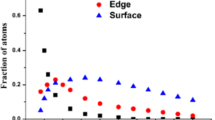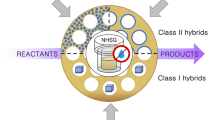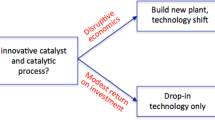Abstract
The use of sol–gel processes is discussed in the development of silica-supported/encapsulated catalysts applied for dry methane reforming (DRM), hydrogenation, hydrolysis, oxidation, photocatalysis and polymerization processes. The systems are discussed in terms of their synthesis routes and performance/applications. Base-catalyzed sol–gel is the most commonly used route among hydrolytic and nonhydrolytic processes, and it results in spherical and compact encapsulated catalysts. Moreover, microspherical, microcapsule and bimetallic core catalysts are exclusive to this route. New methods that use mild conditions for oxidation via enzymes and yeast cells are reported; these methods use a basic route followed by a neutral pH step with no alcohol formation. Nonhydrolytic routes are still relevant for the encapsulation of metallocenes. Silica encapsulation enables a broad range of applications for supported catalysts; therefore, industrial catalyst innovation continues to yield catalysts made of more efficient and recyclable materials for applications ranging from the reformation of methane-forming syngas to biosensors obtained through biocatalytic activities via enzymes.

Graphical abstract
Highlights
-
Research conducted within the last 5 years on the fabrication of supported catalysts using sol–gel routes is discussed.
-
Examples of sol–gel supported catalysts for dry methane reforming, hydrogenation, hydrolysis, oxidation, photocatalysis and polymerization are provided.
-
Encapsulation is aimed at providing supported catalysts that are stable and recyclable and have low production costs.
-
Mild conditions that involve the use of a two-step route, with a basic sol–gel route followed by a neutral pH step, show new possibilities for enzyme and yeast cell encapsulation.






Similar content being viewed by others
References
Catalyst (2009) IUPAC Compendium of Chemical Terminology. Blackwell Scientific Publications, Oxford, https://doi.org/10.1351/goldbook.C00876. ISBN 978-0-9678550-9-7
Business Wire (1961), San Francisco. https://www.businesswire.com/news/home/20210615005560/en/Global-Industrial-Catalyst-Market-Report-2021-Industry-Trends-Share-Size-Growth-Opportunity-and-Forecast-2015-2020-2021-2026--ResearchAndMarkets.com Accessed 07.12.2021
Business Wire (1961), San Francisco. https://www.marketwatch.com/press-release/industrial-catalyst-market-size-2021-with-cagr-of-26-top-growth-companies-basf-johnson-matthey-clariant-and-end-user-swot-analysis-in-industry-2026-2021-06-28 Accessed 07.12.2021
Global Supported Catalyst Market by Type (Nickel Based Supported Catalysts, Precious Metal Based Supported Catalysts, Other Supported Catalysts), By Application (Oil And Gas, Water And Wastewater, Chemical Process, Others) And By Region (North America, Latin America, Europe, Asia Pacific and Middle East & Africa), Forecast From 2022 To 2030. https://dataintelo.com/report/global-supported-catalyst-market/?utm_campaign=copy
Brown T, Lemay H, Bursten B, Murphy C, Woodward P, Stoltzfus M (2017) Chemistry: the central science. Prentice Hall, Upper Saddle River, NJ
IUPAC (1997) Compendium of Chemical Terminology, 2nd ed. (the “Gold Book”). Compiled by A. D. McNaught and A. Wilkinson. Blackwell Scientific Publications, Oxford, Online version (2019-) created by S. J. Chalk. ISBN 0-9678550-9-8. https://doi.org/10.1351/goldbook
Hüsing N, Schubert U (2004) Synthesis of Inorganic Materials, 2nd Edition. Wiley-VCH, Vienna
Parashar M, Shukla VK, Singh R (2020) Metal oxides nanoparticles via sol-gel method: a review on synthesis, characterization and applications. J Mater Sci Mater Electron 31:3729–3749
Navas D, Fuentes S, Castro-Alvarez A, Chavez-Ang E (2021) A review on Sol-Gel Synthesis of Perovskite and Oxide Nanomaterials. Gels 7:275
Lee J-H, Park SJ (2020) Recent advances in preparations and applications of carbon aerogels: A review. Carbon 163:1–18
Gao X-R, Xing Z, Li ZJ, Dong Z-Y, Ju Z-C, Guo C-L (2020) A review on recent advances in carbon aerogels: their preparation and use in alkali-metal ion batteries. N Carbon Mater 35:486–507
Jongkind LJ, Caumes X, Hartendorp APT, Reek JNH (2018) Ligand Template Strategies for Catalyst Encapsulation. Acc Chem Res 51(9):2115–2128. https://doi.org/10.1021/acs.accounts.8b00345
Otor HO, Steiner JB, García-Sancho C, Alba-Rubio AC (2020) Encapsulation Methods for Control of Catalyst Deactivation: A Review. ACS Catal 10(14):7630–7656. https://doi.org/10.1021/acscatal.0c01569
Dragnea D, Gudovan D, Zahara E, Bildea CS (2018) The Treatment of Aluminium Pigments with Inorganic Polymers for Environment-Friendly Applications. Rev Chim 69(12):3353–3360. https://doi.org/10.37358/RC.18.12.6748
Ashraf MA, Khan AM, Ahmad M, Sarfraz M (2015) Effectiveness of silica based sol-gel microencapsulation method for odorants and flavors leading to sustainable environment. Front Chem 3:42. https://doi.org/10.3389/fchem.2015.00042
Meistelman M, Adhikary J, Burg A, Shamir D, Gershinsky G, Meyerstein D, Albo Y (2017) Ag0 and Au0 nanoparticles encapsulated in sol-gel matrices as catalysts in reductive de-halogenation reactions. ChimicaOggi/Chem Today 35(5):23–26
Pagliaro M (2020) Sol–gel catalysts for synthetic organic chemistry: milestones in 30 years of successful innovation. J Sol-Gel SciTechnol 95:551–561. https://doi.org/10.1007/s10971-020-05266-3
Ward DA, Ko EI (1995) Preparing Catalytic Materials by the Sol-Gel Method. Ind Eng Chem Res 34(2):421–433. https://doi.org/10.1021/ie00041a001
Ciriminna R, Pagliaro M (2004) Catalysis by Sol-Gels: An Advanced Technology for Organic Chemistry. Curr Org Chem 8:1851. https://doi.org/10.2174/1385272043369449
Wang X, Ahmed NB, Alvarez G, Tuttolomondo MV, Helary C, Desimone M, Coradin T (2015) Sol-Gel Encapsulation of Biomolecules and Cells for Medicinal Applications. Curr Top Med Chem 15(3):223–244. https://doi.org/10.2174/1568026614666141229112734
Pierre AC (2009) The Sol–Gel Encapsulation of Enzymes. Biocatal Biotransform 22(3):145–170. https://doi.org/10.1080/10242420412331283314
Sepeur S (2008). Silane-technology as the key to Chemical Nanotechnology, In: Nanotechnology: Technical Basics and Applications, Vincentz Network, Hannover: 19-29
Musgo J, Echeverría JC, Estella J, Laguna M, Garrido JJ (2019) Ammonia-catalyzed silica xerogels: Simultaneous effects of pH, synthesis temperature, and ethanol: TEOS and water: TEOS molar ratios on textural and structural properties. Microporous Mesoporous Mater 118(1–3):280–287. https://doi.org/10.1016/j.micromeso.2008.08.044
Debecker DP, Mutin PH (2012) Non-hydrolytic sol-gel routes to heterogeneous catalysts. Chem Soc Rev 41:3624–3650. https://doi.org/10.1039/C2CS15330K
Winter R, Chan J-B, Frattini R, Jonas J (1988) The effect of fluoride on the sol-gel process. J Non-Crystalline Solids 105(3):214–222. https://doi.org/10.1016/0022-3093(88)90310-9
Abdullah B, AbdGhani NA, Vo D-VN. Recent advances in dry reforming of methane over Ni-based catalysts. J Clean Prod 162:170–185. https://doi.org/10.1016/j.jclepro.2017.05.176
Owgi AHK, Jalil AA, Hussain I, Hassan NS, Hambali HU, Siang TJ, Vo D-VN (2021) Catalytic systems for enhanced carbon dioxide reforming of methane: a review. Environ Chem Lett https://doi.org/10.1007/s10311-020-01164-w
Qin Z, Chen J, Xie X, Xuan L, Hongbing J (2020) CO2 reforming of CH4 to syngas over nickel-based catalysts. Environ ChemLett 18:997–1017. https://doi.org/10.1007/s10311-020-00996-w
Singh R, Dhir A, Mohapatra SK, Mahla SK (2020) Dry reforming of methane using various catalysts in the process: review. Biomass Conv Bioref 10:567–587. https://doi.org/10.1007/s13399-019-00417-11
Gunduz-Meric G, Kaytakoglu S, Degirmenci L (2020) Catalytic performance of silica covered bimetallic nickel-iron encapsulated core-shell microspheres for hydrogen production. Int J Hydrog Energy 45(60):34547–34556. https://doi.org/10.1016/j.ijhydene.2020.04.189
Gunduz-Meric G, Kaytakoglu S, Degirmenci L (2019) Ni,Co/SiO2 and Ni/SiO2,Co bimetallic microsphere catalysts indicating high activity and stability in the dry reforming of methane. React Kinet Mech Catal 129(1):403–419. https://doi.org/10.1007/s11144-019-01708-4
Damouny CW, Hayek N, Khoury C, Gazit OM (2019) Composite Assisted Approach for the Synthesis of Ni@SiO2-ZrO2Catalysts and Their Performance Evaluation in Methane Dry Reforming. ACS Appl Energy Mater 2(9):6505–6512. https://doi.org/10.1021/acsaem.9b01086
Du C, Hondo E, Chizema LG, Wang C, Tong M, Xing C, Yang R, Lu P, Tsubaki N (2020) Developing Cu-MOR@SiO2 Core-Shell Catalyst Microcapsules for Two-Stage Ethanol Direct. Ind Eng Chem Res 59(8):3293–3300. https://doi.org/10.1021/acs.iecr.9b05663
Wei J, Zou L, Li Y (2019) Facile synthesis of hollow structured mesoporous silica nanoreactors with confined ultra-small Pd NPs for efficient hydrogenation reactions. J Porous Mater 26(1):157–162. https://doi.org/10.1007/s10934-018-0632-1
Ye R-P, Lin L, Chen C-C, Yang J-X, Li F, Zhang X, Li D-J, Qin Y-Y, Zhou Z, Yao Y-G (2018) Synthesis of Robust MOF-Derived Cu/SiO2 Catalyst with Low Copper Loading via Sol-Gel Method for the Dimethyl Oxalate Hydrogenation Reaction. ACS Catal 8(4):3382–3394. https://doi.org/10.1021/acscatal.8b00501
Nesterov NS, Smirnov AA, Pakharukova VP, Yakovlev VA, Martyanov ON (2021) Advanced green approaches for the synthesis of NiCu-containing catalysts for the hydrodeoxygenation of anisole. Catal Today 379:262–271
Caresani JRF, Dallegrave A, dos Santos JHZ (2021). Amylases encapsulated in organosilane-modified silicas prepared by sol–gel: evaluation of starch saccharification. Journal of Sol-Gel Science and Technology. https://doi.org/10.1007/s10971-020-05446-1
Caresani JRF, Dallegrave A, dos Santos JHZ (2019) Amylases immobilization by sol–gel entrapment: application for starch hydrolysis. J Sol-Gel Sci Technol 94:229–240. https://doi.org/10.1007/s10971-019-05136-7
Escobar S, Bernal C, Bolivar JM, Nidetzky B, López-Gallego F, Mesa M (2018) Understanding the silica-based sol-gel encapsulation mechanism of Thermomyceslanuginosus lipase: The role of polyethylenimine. Mol Catal 449:106–113. https://doi.org/10.1016/j.mcat.2018.02.024
Pavel I-A, Prazeres SF, Montalvo G, A Ruiz CG, Nicolas V, Celzard A, Dehez F, Canabady-Rochelle L, Canilho N, Pasc A (2017) Effect of Mesovs Macro Size of Hierarchical Porous Silica on the Adsorption and Activity of Immobilized β-Galactosidase. Langmuir 33(13):3333–3340. https://doi.org/10.1021/acs.langmuir.7b00134
Yildiz H, Ozyilmaz E, Bhatti AA, Yilmaz M (2017) Enantioselective resolution of racemic flurbiprofen methyl ester by lipase encapsulated mercaptocalix[4]arenes capped Fe3O4 nanoparticles. Bioprocess Biosyst Eng 40(8):1189–1196. https://doi.org/10.1007/s00449-017-1779-x
Ozyilmaz E, Bayrakci M, Yilmaz M (2016) Improvement of catalytic activity of Candida rugosa lipase in the presence of calix[4]arene bearing iminodicarboxylic/phosphonic acid complexes modified iron oxide nanoparticles. Bioorg Chem 65:1–8. https://doi.org/10.1016/j.bioorg.2015.12.001
Beatriz B, Paula G-P, Francisco B-V. Immobilization of Enzymes: A Literature Survey. In. Jose M. Guisan (ed.), Immobilization of Enzymes and Cells: Third Edition, Methods in Molecular Biology, vol. 1051, pp. 15–17. https://doi.org/10.1007/978-1-62703-550-7_2
El Fergani M, Candu N, Tudorache M, Granger P, Parvulescu VI, Coman, SM (2020). Optimized Nb-Based Zeolites as Catalysts for the Synthesis of Succinic Acid and FDCA. Molecules (Basel, Switzerland) 25(21). https://doi.org/10.3390/molecules25214885
Podolean I, Kuncser V, Gheorghe N, Macovei D, Parvulescu VI,Coman SM (2013) Ru-based magnetic nanoparticles (MNP) for succinic acid synthesis from levulinic acid. Green Chem 15:3077–3082. https://doi.org/10.1039/C3GC41120F
Kato K, Lee S, Nagata F (2020) Efficient enzyme encapsulation inside sol-gel silica sheets prepared by poly-L-lysine as a catalyst. J Asian Ceram Societies 8(2):396–406. https://doi.org/10.1080/21870764.2020.1747167
Pylypchuk IV, Daniel G, Kessler VG, Seisenbaeva GA (2020) Removal of diclofenac, paracetamol, and carbamazepine from model aqueous solutions by magnetic sol–gel encapsulated horseradish peroxidase and lignin peroxidase composites. Nanomaterials 10(2):282. https://doi.org/10.3390/nano10020282
Lavrova DG, Kamanina OA, Machulin AV, Suzina NE, Alferov VA, Ponamoreva ON (2020). Effect of polyethylene glycol additives on structure, stability, and biocatalytic activity of ormosil sol–gel encapsulated yeast cells. Journal of Sol-Gel Science and Technology 88(1). https://doi.org/10.1007/s10971-017-4333-z
Tananaiko O, Trofimchuk A, Nechiporuk Y, Garbuz V, Muratov V, Vasil’ev O, Duda T, Biloivan O (2018). Planar Electrodes Modified by Nanodiamonds and Biocomposite Silica-Choline Oxidase Film for Choline Determination. 2018 IEEE 38th International Conference on Electronics and Nanotechnology, ELNANO 2018—Proceedings 8477433:411–416. https://doi.org/10.1109/ELNANO.2018.8477433
Yuan M, Li D, Zhao X, Ma W, Kong K, Gu Q, Hou Z (2018) Selective oxidation of glycerol with hydrogen peroxide using silica-encapsulated heteropolyacid catalyst. Acta Phys Chim Sin 34(8):886–895. https://doi.org/10.3866/PKU.WHXB201711151
Gill JK, Orsat V, Kermasha S (2018) Screening trials for the encapsulation of laccase enzymatic extract in silica sol-gel. J Sol-Gel Sci Technol 85(3):657–663. https://doi.org/10.1007/s10971-017-4575-9
Soni Y, Kumar AEA, Nayak C, Deepak FL, Vinod CP (2017) A Convenient Route for Au@Ti-SiO2 Nanocatalyst Synthesis and Its Application for Room Temperature CO Oxidation. J Phys Chem C 121(9):4946–4957. https://doi.org/10.1021/acs.jpcc.6b10202
Li X, Cai T, Kang E-T (2016) Yolk-Shell Nanocomposites of a Gold Nanocore Encapsulated in an ElectroactivePolyaniline Shell for Catalytic Aerobic Oxidation. ACS Omega 1(1):160–167. https://doi.org/10.1021/acsomega.6b00062
Nogueira RFP, Jardim WF (1998) Heterogeneous photocatalysis and its environmental application. Química Nova 21:1. https://doi.org/10.1590/S0100-40421998000100011. (in portuguese)
Coronado JM (2013) A Historical Introduction to Photocatalysis. In: Coronado J, Fresno F, Hernández-Alonso M, Portela R (eds) Design of Advanced Photocatalytic Materials for Energy and Environmental Applications. Green Energy and Technology. Springer, London, https://doi.org/10.1007/978-1-4471-5061-9_1
Jacinto MJ, Ferreira LF, Silva VC (2020) Magnetic materials for photocatalytic applications—a review. J Sol-Gel Sci Technol 96:1–14. https://doi.org/10.1007/s10971-020-05333-9
Wilson M, Cheng CYC, Oswald G, Srivastava R, Beaumont SK, Badyal JPS (2017) Magnetic recyclable microcomposite silica-steel core with TiO2 nanocomposite shell photocatalysts for sustainable water purification. Colloids Surf A Physicochemical Eng Asp 523:27–37. https://doi.org/10.1016/j.colsurfa.2017.03.034
Escobar CC, Dallegrave A, Lasarin MA, dos Santos JHZ (2015) The sol–gel route effect on the preparation of molecularly imprinted silica-based materials for selective and competitive photocatalysis. Colloids Surf A Physicochemical Eng Asp 486:96–105. https://doi.org/10.1016/j.colsurfa.2015.09.027
Fisch AG, Cardozo NSM, Secchi AR, Stedile FC, Livotto PR, de Sá DS, da Rocha ZN, dos Santos JHZ (2009) Immobilization of metallocenewithinsilica–titania by a non-hydrolytic sol–gel method. Appl Catal A 354:88–101
Capeletti LB, Alves MCM, Cardoso MB, dos Santos JHZ (2018) Hybrid silica based catalysts prepared by the encapsulation of zirconocene compound via non-hydrolytic sol-gel method for ethylene polymerization. Appl Catal A Gen 560:225–235. https://doi.org/10.1016/j.apcata.2018.03.013
Heck CA, Stedile FC, dos Santos JHZ (2021) Metallocene encapsulated within a hybrid silica-polystyrene support. Iran Polym J 30:495–503. https://doi.org/10.1007/s13726-021-00906-z
Ullmann MA. Non-Hydrolytic Sol-Gel Synthesis in the Heterogenization of Metallocenes in Hybrid Silicas for Polyethylene Production (2019).Thesis (Chemistry PhD) - Programa de Pós-Graduação em Química da Universidade Federal do Rio Grande do Sul, Porto Alegre (in Portuguese)
Fisch AG, da Silveira Jr N, Cardozo NSM, Secchi AR, dos Santos JHZ, Soares JBP (2013) Direct production of ultra-high molecular weight polyethylene with oriented crystalline microstructures. J Mol Catal A Chem 366:74–83
Fidalgo A, Ciriminna R, Ilharco LM, Pagliaro M (2005) Role of the Alkyl−Alkoxide Precursor on the Structure and Catalytic Properties of Hybrid Sol−Gel Catalysts. Chem Mater 17(26):6686–6694. https://doi.org/10.1021/cm051954x
Xu P, Wu Z, Dai W, Wang Y, Zheng M, Su X, Teng Z (2021) Synthesis of multiple Ag nanoparticles loaded hollow mesoporous carbon spheres for highly efficient and recyclable catalysis. Microporous Mesoporous Mater 314:110856. https://doi.org/10.1016/j.micromeso.2020.110856
Bhaskaruni SVHS, Maddila S, Gangu KK, Jonnalagadda SB (2020) A review on multi-component green synthesis of N-containing heterocycles using mixed oxides as heterogeneous catalysts. Arab J Chem 13(1):1142–1178
Patrow JG, Yukun C, Pyles CG, Luo B, Tonks IA, Massari AM (2020) Spectroscopic Study of Sol-Gel Entrapped TrirutheniumDodecacarbonylCatalyst Reveals Hydride Formation. J Phys Chem Lett 11(17):7394–7399. https://doi.org/10.1021/acs.jpclett.0c02316
Martin LS, Ceron A, Oliveira PC, Zanin GM, de Castro HF (2018) Different organic components on silica hybrid matrices modulate the lipase inhibition by the glycerol formed in continuous transesterification reactions. J Ind Eng Chem 62:462–470
Shalygin AS, Nuzhdin AL, Bukhtiyarova GA, Martyanov ON (2017) Preparation of HKUST-1@silica aerogel composite for continuous flow catalysis. J Sol-Gel Sci Technol 84:446–452. https://doi.org/10.1007/s10971-017-4455-3
Ding M, Jiang H (2021) Improving Water Stability of Metal-Organic Frameworks by a General Surface Hydrophobic Polymerization. CCS Chem 3(8):2740–2748. https://doi.org/10.31635/ccschem.020.202000515
Acknowledgements
This work was financed by FAPERGS (Project 19/2551-0001869-0). AR is grateful for his PIBIC grant.
Author information
Authors and Affiliations
Corresponding author
Ethics declarations
Conflict of interest
The authors declare no competing interests.
Additional information
Publisher’s note Springer Nature remains neutral with regard to jurisdictional claims in published maps and institutional affiliations.
Supplementary information
Rights and permissions
Springer Nature or its licensor (e.g. a society or other partner) holds exclusive rights to this article under a publishing agreement with the author(s) or other rightsholder(s); author self-archiving of the accepted manuscript version of this article is solely governed by the terms of such publishing agreement and applicable law.
About this article
Cite this article
Rex, A., dos Santos, J.H.Z. The use of sol–gel processes in the development of supported catalysts. J Sol-Gel Sci Technol 105, 30–49 (2023). https://doi.org/10.1007/s10971-022-05975-x
Received:
Accepted:
Published:
Issue Date:
DOI: https://doi.org/10.1007/s10971-022-05975-x




